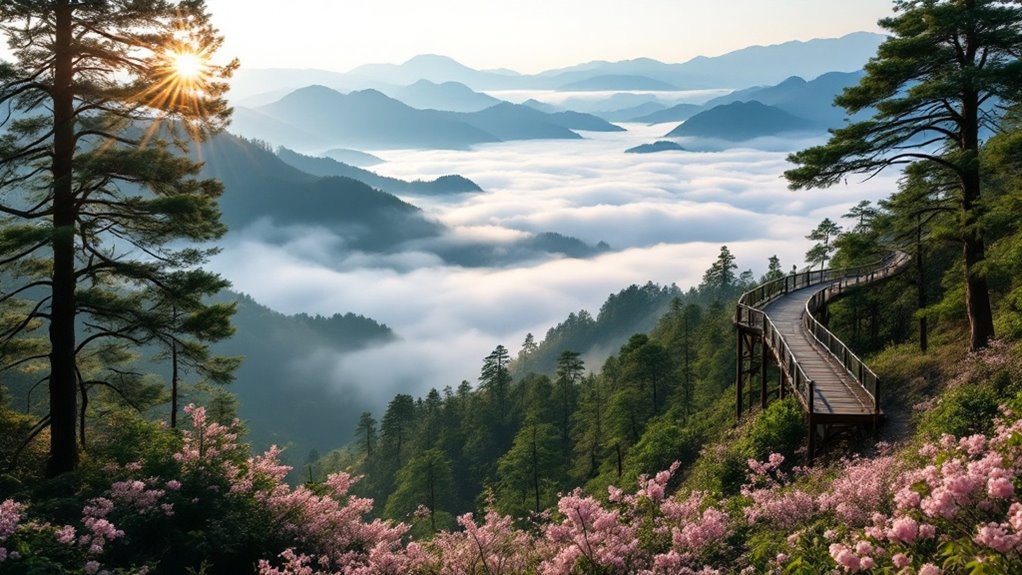Physical Address
304 North Cardinal St.
Dorchester Center, MA 02124
Physical Address
304 North Cardinal St.
Dorchester Center, MA 02124

When visiting Alishan National Park, you’ll want to time your trip for spring or autumn’s moderate temperatures, book accommodations 3-6 months ahead, and pack layered clothing with hiking gear. You should utilize the efficient shuttle buses and forest railway system, bring sufficient cash, and respect local customs like proper chopstick etiquette. The park’s stunning sunrise views, ancient cypress forests, and rich Tsou culture offer countless experiences to explore and discover.

The timing of your visit to Alishan National Park can dramatically shape your experience, with each season offering distinct advantages and challenges.
Every season in Alishan tells a different story, each with its own rewards and obstacles for adventurous travelers.
If you’re hoping to witness the iconic cherry blossoms, plan your trip for late March to early April, but book accommodations 3-6 months ahead due to the 2 million annual visitors during this period. The mild temperatures during spring hover between 10-20°C, making outdoor exploration particularly pleasant.
For ideal hiking conditions and photography, consider visiting in October-November when humidity drops to 65% and visibility extends beyond 15km.
Summer travelers should prepare for frequent storms and potential travel disruptions, while winter visitors can enjoy peaceful trails and reduced rates, though temperatures may drop near freezing.
Spring and autumn offer the most balanced experience with moderate temperatures between 14-17°C and manageable rainfall levels.
While exploring Alishan National Park‘s vast network of trails and attractions, you’ll discover several convenient transportation options that work together seamlessly.
Shuttle buses run every 5-10 minutes from the Visitor Center to major trailheads, costing NT$50-80 per ride, while the historic Forest Railway operates three scenic lines with tickets priced at NT$100-150 per segment.
You can combine these options effectively by using shuttles for short hops between trails and taking trains for longer, scenic routes.
If you’re planning to catch the sunrise, you’ll need to book your Chushan Line train ticket the afternoon before.
Don’t forget that showing your public transport ticket at the entrance can reduce your park admission fee from NT$300 to NT$150.
For those planning overnight stays, the baggage room service at the terminal can store your luggage for NT$70 per bag per 24-hour period.

Packing strategically for Alishan National Park‘s diverse environments and weather conditions will guarantee you’re prepared for any situation you might encounter.
As temperatures can drop considerably at higher elevations and weather patterns change quickly, you’ll need to plan your gear carefully, focusing on versatility and practicality. Since the bus ride duration is approximately 2.5 hours, consider bringing motion sickness medication and comfort items for the journey.
Experiencing Alishan’s legendary sunrise requires careful planning and strategic timing to guarantee you’ll witness one of Taiwan’s most breathtaking natural spectacles.
Plan meticulously for Alishan’s sunrise spectacle – a natural wonder that rewards only those who time their visit perfectly.
You’ll want to arrive 60-90 minutes before sunrise, particularly during peak months from October to April, when viewing conditions are ideal. While Zhushan Station offers popular panoramic views at 2,451m, consider alternatives like Xiaoliyuanshan Lookout for superior vistas with smaller crowds.
For transportation, you can take the early-morning Alishan Forest Railway from Alishan Station to Zhushan, but be sure to purchase tickets in advance. Rapid weather changes in the mountains mean you should dress in layers and bring a rain jacket just in case.
If you’re seeking a more adventurous approach, try hiking trails from Zhaoping Park. Remember to check weather forecasts, as clear nights with visible stars typically signal ideal viewing conditions the following morning.

Three distinct accommodation tiers await visitors to Alishan National Park, ranging from budget-friendly guesthouses to luxurious mountain retreats.
You’ll discover options to match any travel style, from the basic Alishan Gou Hotel to the upscale Hotel Indigo with its modern amenities and shuttle service.
For the best experience, consider staying within 0.8 miles of the park entrance to maximize your time and avoid daily re-entry fees.
Hotels in the area typically offer fully refundable bookings for added peace of mind when planning your stay.
After settling into your chosen accommodation, Alishan National Park’s remarkable attractions await your discovery. You won’t want to miss the sunrise viewing at Jhushan station, where you’ll observe Yushan peak emerging from a sea of clouds.
Along the Giant Tree Trail, you’ll encounter ancient red cypress trees that have stood for over 2,000 years, while the Sister Ponds offer a serene setting steeped in local legend. With temperatures significantly lower at altitude, Alishan provides a welcome cool climate escape from Taiwan’s tropical heat.
For an off-the-beaten-path experience, take the disused railway tracks to the 2,700-year-old Shuishan Giant Tree, or explore the Tea Mist Trail leading to Xiding Lookout Platform.
During spring, you’ll discover cherry blossoms in full bloom at Zhaoping Park, and if you’re visiting in April or May, don’t miss the mesmerizing firefly displays in the Shizhuo area after dark.

To fully appreciate your visit to Alishan National Park, you’ll need to understand the rich tapestry of local customs and cultural etiquette that shape daily interactions.
When exploring the area, particularly in temple visits and encounters with the indigenous Tsou tribe, showing proper respect is essential for meaningful cultural exchanges. If locals invite you to their home, consider it a special honor that reflects relationship development status.
Follow these customs to demonstrate respect and enhance your cultural experience in Alishan.
Armed with these essential insights, you’re now ready to commence your Alishan adventure with confidence. From catching the legendary sunrise over the sea of clouds to charting the charming forest railway, you’ll experience Taiwan’s natural wonder at its finest. Remember to respect local customs, pack strategically, and take your time exploring this mountain paradise. Your journey through Alishan’s misty peaks and ancient forests awaits.